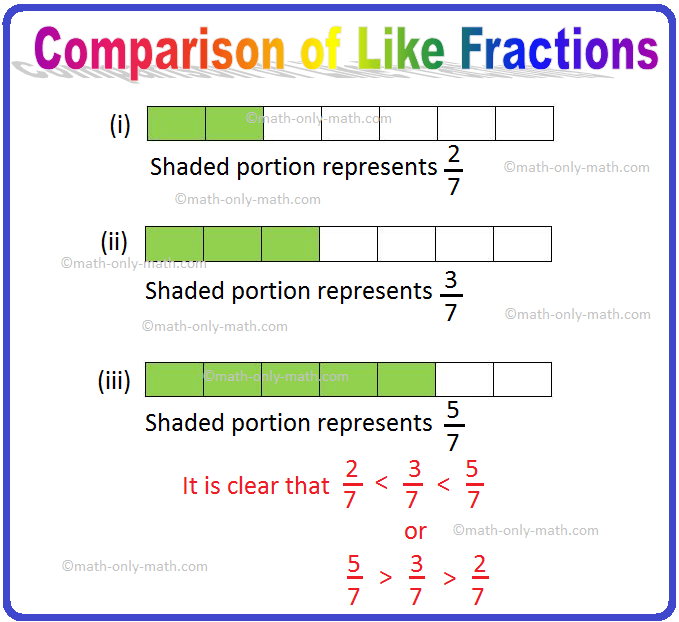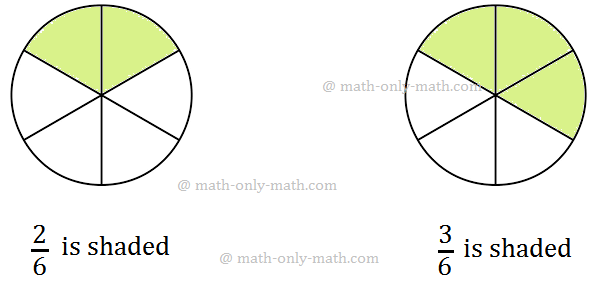Subscribe to our ▶️ YouTube channel 🔴 for the latest videos, updates, and tips.
Comparison of Like Fractions
Any two like fractions can be compared by comparing their numerators. The fraction with larger numerator is greater than the fraction with smaller numerator, for example \(\frac{7}{13}\) > \(\frac{2}{13}\) because 7 > 2.
1. In comparison of like fractions here are some rectangular figures.
(i)
In (i) shaded portion represents \(\frac{2}{7}\)
(ii)
In (ii) shaded portion represents \(\frac{3}{7}\)
(iii)
In (iii) shaded portion represents \(\frac{5}{7}\)
It is clear that \(\frac{2}{7}\) < \(\frac{3}{7}\) < \(\frac{5}{7}\)
or \(\frac{5}{7}\) > \(\frac{3}{7}\) > \(\frac{2}{7}\)
Thus, in like fractions or fractions having same denominator, that fraction is greater which has the greater numerator.
Accordingly, \(\frac{3}{5}\) > \(\frac{2}{5}\); \(\frac{2}{5}\) < \(\frac{3}{5}\)
\(\frac{15}{17}\) > \(\frac{10}{17}\); \(\frac{10}{17}\) < \(\frac{15}{17}\)
2. Again, let us consider \(\frac{2}{5}\) and \(\frac{3}{5}\).
3 > 2
Hence, for any two like fractions, the fraction with the larger numerator is greater than the fraction with smaller numerator.
If
there are three or more like fractions, they may be arranged in
ascending (increasing) and descending (decreasing) order. The order will
be according to the order of the numerators.
(a) Ascending order: \(\frac{1}{9}\), \(\frac{2}{9}\), \(\frac{3}{9}\), \(\frac{4}{9}\), \(\frac{5}{9}\), \(\frac{6}{9}\), \(\frac{7}{9}\), \(\frac{8}{9}\):
as, 1 < 2 < 3 < 4 < 5 < 6 < 7 < 8
(b) Descending order: \(\frac{8}{9}\), \(\frac{7}{9}\), \(\frac{5}{9}\), \(\frac{4}{9}\), \(\frac{3}{9}\), \(\frac{2}{9}\), \(\frac{1}{9}\):
as, 8 > 7 > 5 > 4 > 3 > 2 > 1
Similarly again;
(a) Ascending order: \(\frac{5}{17}\), \(\frac{7}{17}\), \(\frac{8}{17}\), \(\frac{11}{17}\), \(\frac{13}{17}\), \(\frac{14}{17}\), \(\frac{16}{17}\):
as, 5 < 7 < 8 < 11 < 13 < 14 < 16
(b) Descending order: \(\frac{16}{17}\), \(\frac{14}{17}\), \(\frac{13}{17}\), \(\frac{11}{17}\), \(\frac{8}{17}\), \(\frac{7}{17}\), \(\frac{5}{17}\):
as, 16 > 14 > 13 > 11 > 8 > 7 > 5
Comparison of Fractions:
Case I: Fractions with same Denominator:
If two fractions have the same denominator, the fraction with greater numerator denotes the greater fraction.
For example,
\(\frac{6}{9}\) > \(\frac{4}{9}\)
\(\frac{2}{3}\) < \(\frac{5}{3}\)
Comparison of fractions with the same denominator
Observe the following figures.
In the first figure, 2 parts out of 6 equal parts are shaded.
In the second figure, 3 parts out of 6 equal parts are shaded.
Clearly, shaded parts in the second circle are more than those in the first circle.
Thus, \(\frac{3}{6}\) > \(\frac{2}{6}\) or \(\frac{2}{6}\) < \(\frac{3}{6}\)
Hence, among two fractions having the same denominator, the fraction with the greater numerator is greater than the other.
1. Compare \(\frac{2}{5}\) and \(\frac{4}{5}\)
Solution:
Consider \(\frac{2}{5}\), \(\frac{4}{5}\)
Since, 4 > 2, hence \(\frac{4}{5}\) > \(\frac{2}{5}\) or \(\frac{2}{5}\) < \(\frac{4}{5}\)
2. Compare \(\frac{7}{15}\) and \(\frac{8}{15}\)
Solution:
Consider \(\frac{7}{15}\), \(\frac{8}{15}\)
Since, 8 > 7, hence \(\frac{8}{15}\) > \(\frac{7}{15}\) or \(\frac{7}{15}\) < \(\frac{8}{15}\)
Three or more like fractions can be arranged in ascending or descending order by arranging their numerators in ascending or descending order.
For example, the fractions \(\frac{8}{11}\), \(\frac{7}{11}\), \(\frac{10}{11}\), \(\frac{3}{11}\) can be arranged in the ascending order as \(\frac{3}{11}\) < \(\frac{7}{11}\) < \(\frac{8}{11}\) < \(\frac{10}{11}\)
Case II: Fraction with Like Numerators:
The fraction with smaller denominator is greater.
Examples:
\(\frac{4}{7}\) > \(\frac{4}{10}\);
\(\frac{8}{13}\) > \(\frac{8}{17}\);
\(\frac{18}{33}\) > \(\frac{18}{41}\) etc.
Similarly, \(\frac{3}{5}\) < \(\frac{3}{4}\);
\(\frac{11}{13}\) < \(\frac{11}{10}\);
\(\frac{25}{42}\) < \(\frac{25}{37}\) etc.
Worksheet on Comparison of Like Fractions:
1. Compare the given fractions and put the right sign <,> or =.
(i) \(\frac{7}{4}\) …… \(\frac{11}{4}\)
(ii) \(\frac{8}{13}\) …… \(\frac{2}{13}\)
(iii) \(\frac{5}{24}\) …… \(\frac{7}{24}\)
Answers:
1. (i) <
(ii) >
(iii) <
2. Put the appropriate sign >, < or = in the box.
(i) \(\frac{3}{8}\) ______ \(\frac{2}{8}\)
(ii) \(\frac{11}{7}\) ______ \(\frac{13}{7}\)
(iii) \(\frac{2}{9}\) ______ \(\frac{7}{9}\)
(iv) \(\frac{5}{11}\) ______ \(\frac{1}{11}\)
Answers:
2. (i) >
(ii) <
(iii) <
(iv) >
Related Concept
- Fraction of a Whole Numbers
- Representation of a Fraction
- Equivalent Fractions
- Properties of Equivalent Fractions
- Like and Unlike Fractions
- Comparison of Like Fractions
- Comparison of Fractions having the same Numerator
- Types of Fractions
- Changing Fractions
- Conversion of Fractions into Fractions having Same Denominator
- Conversion of a Fraction into its Smallest and Simplest Form
- Addition of Fractions having the Same Denominator
- Subtraction of Fractions having the Same Denominator
- Addition and Subtraction of Fractions on the Fraction Number Line
- Word Problems on Multiplication of Mixed Fractions
- Worksheet on Word Problems on Multiplication of Mixed Fractions
- Multiplying Fractions
- Dividing Fractions
- Word Problems on Division of Mixed Fractions
- Worksheet on Word Problems on Division of Mixed Fractions
4th Grade Math Activities
From Comparison of Like Fractions to HOME PAGE
Didn't find what you were looking for? Or want to know more information about Math Only Math. Use this Google Search to find what you need.




![To convert a percentage into a fraction, place the given number over 100 and reduce it to its lowest term. Consider the following example: (i) 20% [We know % = 1/100]](/image-thumbnails/convert-a-percentage-into-a-fraction.png/default.webp)














New! Comments
Have your say about what you just read! Leave me a comment in the box below. Ask a Question or Answer a Question.